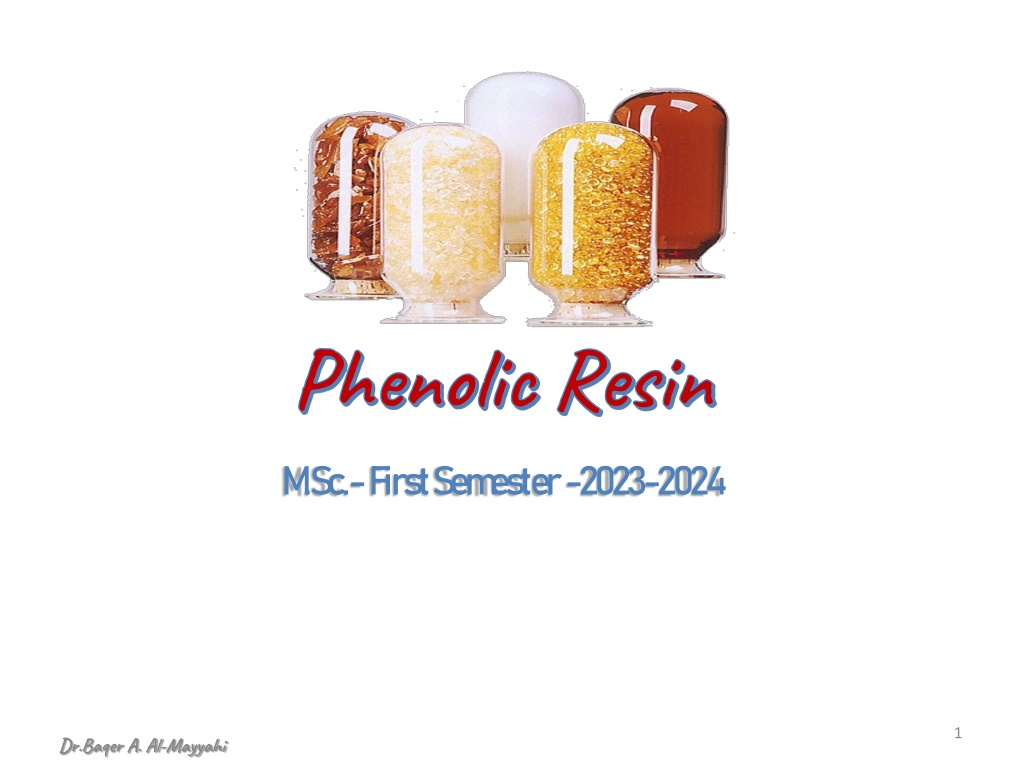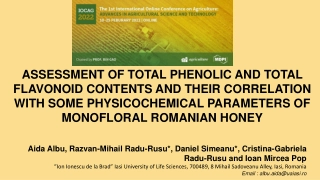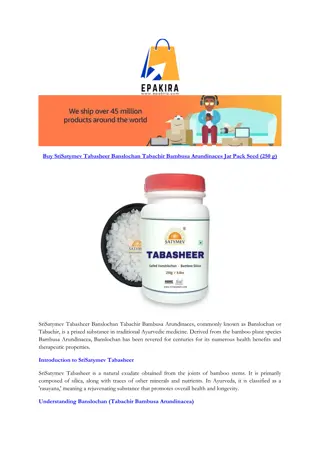Phenolic Resin
Phenolic resins, the oldest synthetic polymer, are produced by reacting phenols with aldehydes, primarily phenol and formaldehyde. This process was invented in 1907 and has since been crucial in manufacturing durable molded parts. Phenols, aromatic compounds with unique properties, play a key role in this production process. The production of phenol involves oxidizing cumene to yield phenol and acetone. Various synthesis processes are explored, highlighting the significance of formaldehyde as the primary carbonyl component.
Download Presentation
Please find below an Image/Link to download the presentation.
The content on the website is provided AS IS for your information and personal use only. It may not be sold, licensed, or shared on other websites without obtaining consent from the author. Download presentation by click this link. If you encounter any issues during the download, it is possible that the publisher has removed the file from their server.
Presentation Transcript
Phenolic Resin M .Sc.- FirstSem ester -2023-2024 1 Dr.Baqer A. Al-Mayyahi
Introduction Phenolic resins are obtained by the reaction of phenols with aldehydes. Both parent compounds, phenol and formaldehyde, are by far the most important components in commercial phenolic resin production Phenolic resins are the oldest commercially manufactured synthetic polymer. They were first 'invented' by Leo Hendrik Baekeland in 1907. He was the one to develop an economical method to convert these resins to moldable formulations which were transformed by heat and pressure into hard and resistant molded parts 2
Phenols Phenols are a family of aromatic compounds with the hydroxyl group bonded directly to the aromatic nucleus. They differ from alcohols in that they behave like weak acids and dissolve readily in aqueous sodium hydroxide, but are insoluble in aqueous sodium carbonate. Phenols are colorless solids with the exception of some liquid alkylphenols. Selected physical properties of phenols are listed in below Table 3
Phenol Production Processes In the commercial process, cumene is oxidized with air to CHP {95% yield) which is concentrated and cleaved in presence of an acidic catalyst at high efficiency (99%) to phenol and acetone 5
Toluene Oxidation Process Other Synthesis Processes Several other synthesis processes (listed below) have no commercial importance: Chlorination of benzene and alkaline hydrolysis of chlorobenzene Chlorination of benzene and steam hydrolysis of chlorobenzene ( Rasehig process, Raschig-Hooker and Gulf oxychlorination process) Sulfonation of benzene and benzenesulfonate decomposition in molten sodium hydroxide to sodium phenolate (A. Wurtz and A. Kekule) Cyclohexene conversion to cyclohexanol-cyclohexanone mixtures followed by dehydrogenation to phenol (Mitsui Petrochemical1989) 6
Aldehydes Formaldehyde is practically the only carbonyl component used in the synthesis of industrial phenolic resins. Special resins are made with other aldehydes, e. g., acetaldehyde, butyraldehyde, furfural, glyoxal, or benzaldehyde, but these have not achieved much commercial importance. Ketones are also rarely used. Physical properties of some aldehydes are compiled in Table below 7
Formaldehyde, the first of the series of aliphatic aldehydes, was discovered in 1859 by Butlerov and has been manufactured on a commercial scale since the beginning of the twentieth century. Because of its variety of chemical reactions and relatively low cost (basically reflecting the cost of methanol) it has become one of the most important industrial chemicals. 8
Hexamethylenetetramine Hexamethylenetetramine, HMTA, is by far the most important compound to cure Novolac type of resins. It is prepared from formaldehyde and ammonia according to Eq. below In reverse, HMTA decomposes at elevated temperatures. In aqueous solution, HMTA is easily hydrolyzed to amino methylated compounds and is often used as catalyst in the resole synthesis instead of ammonia. HMTA is quite soluble in water, but less soluble in methanol or ethanol. The aqueous solution exhibits a weak alkaline action with a pH in the range 7-10. In powder form, HMTA is prone to dust explosions. It is ratedas a severe explosion hazard. 9
Basic Chemistry Phenolic resins are obtained by step growth polymerization of difunctional monomers (aldehydes) with monomers of functionality greater than 2 (Phenol, substituted Phenols or combination of phenols). Key factors in the design of the desired phenolic resin are: - Molar ratio of F to P - Mode of catalysis: Acid, base, metal salt, enzyme. Note: Reaction of phenolic compounds with aldehydes under acidic or basic catalyst are exothermic , so side reaction due to exothermic need to be avoided 10
Resole The simplest phenolic component that can cure into a phenolic resin is o- or p-methylol phenol. The reaction of P with Funder basic conditions is initially the addition of F to phenolate leading to o- and p-methylol phenol. 11
Resole Besides monomethylol phenols, some dimethylol phenols, and trimethylol phenol are formed. It is commonly referred to as the Lederer-Manasse reaction. 12
Resole at low temperatures ( 60 C} only addition of formaldehyde to phenol occurs. In a temperature range above 60 C, condensation reactions of methylol phenols with phenol and/or methylol phenols occur and lead to prepolymer or the desired resole resin 13
Novolac the simplest Novolac, is prepared by conducting the reaction of P and F with a large excess of phenol under acidic conditions. A mixture of isomers is obtained: o,p' isomer predominates, followed by p,p' and o,o' 14
Novolac The mechanism of formation involves initial protonation of methylene glycol which reacts with phenol at the ortho and para positions In aqueous solution, formaldehyde exists in equilibrium with methylene glycol. 15
Novolac 16
Non-Hexa Cure It was mentioned earlier that non-hexa curing methods consist of the use of hydroxymethyl derivatives of phenol, bisoxazolines, bisbenzoxazines, and solid resole. Besides bismethylol cresol (11) other bismethylol compounds based on cresol trimer (12), cresol Novolac (13) and Bisphenol A tetramethylol (14) were evaluated: 19
Novolac because it dose not contain reactive groups in their structure , so the curing chemistry must be needed to curing agents like formaline and hexamethylene tetra amine (hexamine ) Heating is very important factor for complete the curing. ? 20
Two prepolymers types are obtained depending on pH Type of Phenolic Resin Novolac Resin Resol Resin Type of Reaction Electrophelic Mechanism Nucleophilic Mechanism Medium of Reaction ( pH) Acidic Med. ( 1-5 ) Basic Med. ( > 7) Molar Ratio ( P:F ) 1: 0.8 1:2- 1:4 Type or behavior of Polymer Linear or Slightly Branch Branch Characteristic Properties Low MWT, Soluble Low MWT , non Soluble 21
Applications of Phenolic Resins UP = unsaturated polyester, PF = phenolic, EP = epoxy, PUR = polyurethane, MF = melamine, UF = urea resin, MMA =methylmethaacrylate) 23
Thank You Thank You 24







